All about rivets for threaded rivets

The threaded rivet rivet is a useful tool for making permanent connections. With its help, you can work with fasteners of different diameters, quickly and efficiently fasten materials together. How to make a tool with your own hands, what is the difference between manual and other screw rivets - the answers to these and other questions should be considered in more detail.


Peculiarities
Threaded riveter is a tool designed to install a special type of universal fastener. It works with special nuts that have a screw-type thread on the inside. After installation, such a rivet can be used for its intended purpose or act as the basis for a threaded connection paired with a bolt or stud. Standard material thicknesses for threaded fasteners are 0.3 to 6 mm.
A special riveting tool is needed in order to successfully mount the mount to its intended place. The principle of operation of the equipment is quite simple. Its design has a special head for rivets - a platform on which one of the parts of the metal retainer is attached. The second is inserted into a pre-made hole, aligned with the tip of the tool, and then subjected to mechanical, pneumatic or other action. The edges of the metal workpiece are flattened, the nut is securely fastened inside the metal or other material.

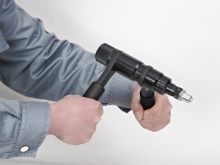

Species overview
Depending on how often the threaded rivets have to be installed, the master can choose the type of tool that is convenient for him. For example, an electric nut gun works much more productively than a manual one. Pneumatic is considered industrial, suitable for installing rivets in line. The principle of operation of the two-hand ratchet riveter differs from the classic pistol version.
By the way of application, it resembles the wrench of the same name, it is suitable for work in places with limited free space.



Manual
Threaded riveters of this type use the principle of a lever in their work: upon contact, the tool squeezes the nut, causing it to deform. Outwardly, it resembles pliers or pliers, but the location of the working area may not be straight, but lateral. There are lever-type riveters with 1 or 2 handles. In the first case, one of the parts of the structure remains static, is part of the tool body, but does not differ in high compression force - they are used on nuts up to 5 mm in diameter. Two-handed models are capable of creating more pressure, suitable for fasteners with a diameter of up to 6.4 mm.
Ratchet rivets are also hand tools, but they have a fundamentally different type of design. They use 2 handles, sequentially fixed on a common axis at right angles to it. The lever force is generated by rotating these elements around the circumference. This tool is ideal for working with large diameter threaded rivets. Available in "second length models" for mounting fasteners into thicker joints.



Telescopic ratchet rivets are a relatively new phenomenon in the hand tool market. They are equipped with levers that allow increasing and decreasing their length in a certain range, independently of each other. This is convenient when working in confined spaces. In addition, the different lengths of the levers provide an increase in the force exerted on the metal when the nut deforms during installation.
Threaded type gear ratchet rivets have a planetary mechanism inside the housing. It increases the force imparted to the driven shaft, speeds up the fastening process by 3-4 times. The costs of physical forces are reduced, and labor productivity is increased.
The tool is designed primarily to work with rivets from M6 to M12.
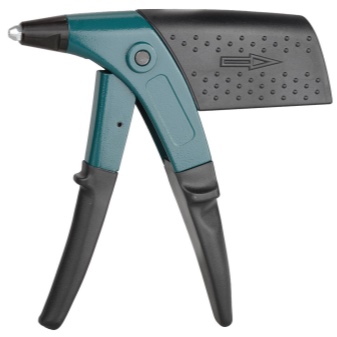
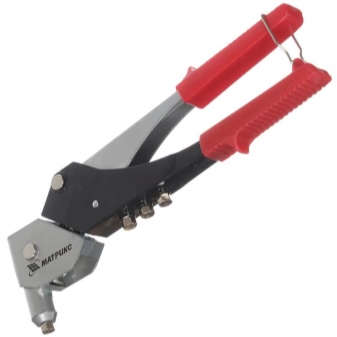
Pneumatic
This type of tool works on the basis of compressed air. The external unit - the compressor - provides a sufficient intensity of impact on the surface of the threaded rivet. This type of equipment can hardly be called portable and compact, it is most often used in the industrial field, in line work.


Pneumohydraulic
Rivet guns of this type are capable of handling the largest diameter fasteners. The combination of pneumatic and hydraulic action provides a significant increase in the force exerted on the nut during deformation. Such high power in everyday life is simply useless. That is why it is recommended to use it for industrial purposes, in production or in private workshops.


Rechargeable
Like classic electric rivets, this tool has a motor connected to a power source in its design. In battery-powered equipment, this role is played by a removable or replaceable battery. The devices are quite autonomous, convenient to use, and have a pistol-type design. The power of the force depends on the performance of the power tool itself; most options cope well with both small and large rivet diameters.
It is advisable to choose battery models in cases where the effort of manual equipment is not enough. If the installation of threaded nuts does not happen too often, you can replace a full-fledged power tool with a conventional adapter for a drill or screwdriver.


How to choose?
When choosing a tool for setting female rivets, it is very important to ensure that it meets the desired parameters. The diameter of the nuts with which you work is important. If manual types of rivets still cope with fasteners of the size M5-M6, then for options M8, M10, M12, you will need a professional battery version or a two-hand ratchet model. A number of important selection criteria should also be noted.
- Rivet material type. It is important to understand that most inexpensive riveters are designed to work with soft aluminum fasteners. They are not suitable for installing steel nuts, the tool may jam. If you plan to work with titanium or stainless rivets, it is better to choose a cordless or hand-held ratchet tool model.
- Effort applied. For home use, a two-handed riveter of any type will be sufficient - with closing handles or a ratchet. If you have to work outdoors or in a summer cottage, it is better to purchase a battery model. It can handle both large diameter rivets and miniature versions.
- Head type. The most versatile is the swivel element, which can be easily installed in any desired position - from the side or straight. This provides easier access to difficult work areas. It is important that it wedges securely in the selected position. If you have to perform the simplest operations, you can take a simple riveting machine with a side head.
- Equipment. Additional set of interchangeable heads, special wrenches, tool lubricant. All this should be present in the basic configuration of a quality product.In addition, the battery model must have replaceable brushes for motors of the appropriate type, a storage case, a charger, and sometimes a replaceable battery.
- Feasibility of the purchase. If the tool is not planned to be used regularly, it would be more expedient to purchase a screwdriver attachment for installing rivets. With frequent use of threaded connections, it is worth choosing the model that best suits your budget.
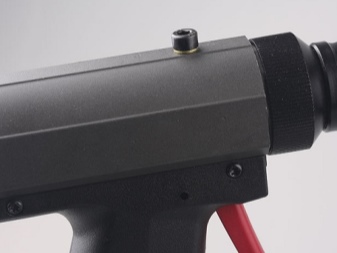

All of these factors directly influence the selection of a suitable riveter for working with threaded nuts. It is worth considering that the difference in cost between a hand-held and a cordless tool is quite large. It is imperative to estimate the scope of work in advance. The pneumatic and hydropneumatic options should only be considered for industrial purchases.
They are not used in everyday life, they will be idle most of the time, while the cost of purchasing equipment will be very significant.


How to do it yourself?
If you do not have a suitable ready-made tool at hand, it is quite possible to make it yourself. This does not require drawings or complex diagrams. The simplest device for installing threaded rivets can be made from an ordinary bolt and nut, and an ordinary bearing, which is used for bushings, is also useful. Let's consider the order of work.
- Select the bolt according to the rivet diameter. It should fit freely into its thread.
- Fasten the nut to the surface of the bolt.
- The bearing is installed as a shock absorber, preventing uneven pressure supply, eliminates seizure. Washers are placed between the rivet and the bearing on the surface of the screw. Their exact number depends on how deep the fastener must enter the surface of the material.
- The surface of the rivet is aligned with the hole. Inside it is the construction of a homemade riveter.
- The nut is wedged with a wrench at the bottom. The screw is turned out, creating a force applied to the rivet. The fastener is flattened by squeezing the edges of the hole.
A bolt with an internal hexagon head is optimal for such a homemade tool. It is convenient to use it as a lever. In any case, such a design cannot be altered, it is designed for 1 time.



How to use?
When using a threaded rivet, the master must carry out the work in stages. Regardless of whether a hand or battery tool is used, you will first have to prepare the surfaces to be connected, select the fasteners and the corresponding head. The procedure includes several points.
- Cleaning of working surfaces. Since threaded rivets are usually fixed in the metal, it is necessary to ensure their reliable contact with the base. Traces of paint and other coatings are removed, burrs and other metal defects are removed. The easiest way is to do a rough file with a file, and a more delicate one with a sander.
- Alignment of layers of bonded material. Better to use a clamp to secure parts of the workpiece in the desired position.
- Marking. With the help of drawing devices, the point of installation of the rivet is selected. A punch marks the area in which the drill bit will abut.
- Making a hole. It is drilled through, immediately through both layers of material, connected by riveting. It is very important to fix the tool tip perpendicular to the plane. The choice of the drill diameter should be slightly smaller than the mount itself - by 1-2 mm. If concealed installation is planned, the hole is countersinked.
- Rivet preparation. A rod is attached to the tool head, the diameter of which corresponds to the internal thread of the nut to be installed. A rivet is tightly screwed onto it until a tangible stop.
- Mounting. The counterpart of the mount is placed in the prepared hole. The rivet head with a screwed nut is installed close to the surface.The tool must be strictly perpendicular, otherwise the connection can be damaged. When a force is applied to the head, the rivet is deformed, it is installed.
- Completion of work. The stem is unscrewed from the resulting threaded connection. The installed rivet is checked for distortions and other defects, traces of deformation in the threaded part. If they are present, you have to remove the mount, start over.

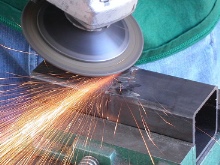

By following these guidelines, you can easily cope with the use of a rivet when installing threaded nuts of different diameters.
In the next video, you will find a detailed overview of a quality threaded rivet riveter.










The comment was sent successfully.